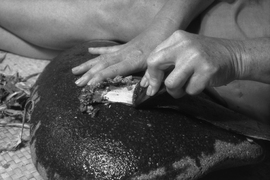
One of Pua’s important contributors was LeVan Sequiera, a Maui woodworker and canoe builder who has researched traditional Hawaiian implements for nearly half a century. Working with Pua, and basing his replications on centuries-old artifacts at the Bishop Museum, Sequiera created the various hohoa, or wooden beaters, for softening and spreading the bark’s fibers: round hohoa for the initial pounding, four-sided beaters whose carved patterns create the watermarks embossed into kapa at a later stage. On each of those four sides, Sequiera carved a different watermark pattern—a painstaking, trial-and-error process, since, like Pua, the woodworker was reinventing a vanished art. Too sharp an edge, and the tool tore through the kapa; too rounded, and it left an indistinct mark.
Though he hastens to downplay his role in her efforts, Pua’s most vital partner has been her husband, Bob Van Dorpe. Without him, she’ll tell you, she could not have rescued kapa-making from oblivion. It was he who encouraged her passion for the art, he who persuaded an O‘ahu collector to sell the Van Dorpes small sections of sixty-five kapas from the seventeenth and eighteenth centuries, to give Pua original material to model her own against. One Christmas, he gave her a microscope. “She was always saying she could never be sure that her work is as fine a quality as the ones made 200 years ago. The only way for her to tell is to compare them under the microscope.”
While her research employs Western technology in the service of this ancient craft, in the actual making of kapa, Pua uses only traditional tools and techniques. She is the twenty-first-century Hawaiian, moving between cultural practices and modern times. Dressed in a mu‘umu‘u or a simple pareo, she sits cross-legged on a lauhala mat, slicing down the length of a harvested wauke sapling with a niho ‘oki (shark-tooth knife), then stripping the bark away by hand. Kneeling beside a pohaku kua, a stone anvil, she takes up the mole-hohoa, the smooth, round beater, and begins the first stage of flattening the fibers. Barefoot, she clambers down a rocky coastline to immerse her kapa in a tide pool to soften the fibers; or wades into a taro lo‘i to bury the kapa in its mud. Her slim, manicured fingers lift slippery balls of fiber pulp from an above-ground imu in which, wrapped in banana leaves, they’ve fermented for weeks. Those same fingers again curl around a hohoa, beating the fibers into a seamless felt—beating for as many as ten hours a day.






i feel we have a lot to appreciate the continuance of a knowledge almost lost from the bottom of my heart thanks to all